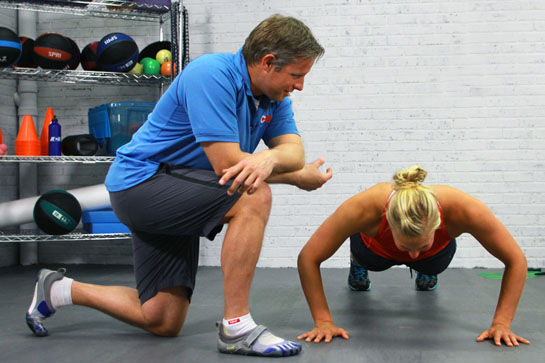
By Carrie Myers
Top-level personal trainers offer their professional opinions on the most common challenges new trainers are likely to face and, more importantly, how to successfully overcome them. Here is your opportunity to learn from their experience and, hopefully, avoid some of the mistakes they made early in their own careers.
JOIN THE CONVERSATION!
What is your greatest challenge about being a personal trainer? What advice would you give to new trainers just starting out? Let us know your thoughts in the comments section below.
Like many other new trainers just starting out, Pete McCall, M.S., an ACE-certified Personal Trainer in San Diego, Calif., ran into some challenges and obstacles. From learning how to effectively communicate with clients and how to market himself and his skills to learning how to ask clients for money, McCall had to acquire a whole slew of new skills that went well beyond designing exercise programs and physically training clients.
Having now worked in the fitness industry for 14 years, McCall is a fitness veteran and an exercise physiologist with the American Council on Exercise. We asked him and several other experienced trainers to give their professional opinions on some common challenges new trainers are likely to face. Their responses are based on their own experiences, including mistakes they made early on in their careers.
1. How can I build a client base?
“Offer free sessions,” suggests Franklin Antoian, ACE-certified Personal Trainer and founder of iBodyFit.com. “Free sessions give you experience and are one of the best word-of-mouth ways to market yourself. While it may eat up some of your time, that doesn’t matter, because you’re not that busy with paying clients [when first beginning] anyway!”
Manning Sumner, owner of LegacyFit in Miami, Fla., agrees with offering free sessions. “The only way people will know whether you know what you are doing or not is to experience your training. I always say, all I need is one session and they will come back for more. You have to be willing to give up your time in order to prove you are worth it.”
“Service, service, service,” emphasizes McCall. “Focus on the client’s needs and establish expectations for the trainer-client relationship. This demonstrates that the trainer is a professional and will go a long way toward improving the trainer’s image and boosting business.”
Joshua Jarmin, owner of The BAR Fitness in Atlanta, Ga., recommends that if you have a difficult time selling your services, begin at a franchised gym. In this case, they usually do the selling for you, but tend to pay less than private gyms.
Jarmin also recommends good old-fashioned grassroots methods, such as creating flyers and posters and distributing them to local schools and businesses. Of course, more modern grassroots methods like the Internet and social media should be used as well. While a blog may not be the right venue for everyone, sites like Facebook, Twitter and Pinterest offer great opportunities to promote your business by providing fitness tips and recommending useful sites and books to your clients or followers/fans.
And remember that people like to take advantage of special offers and discounts. “Get in on coupon deals,” adds Jarmin, “such as Living Social, Groupon and Half-Off Depot. You won’t make much money initially, but it’ll get people in front of you to sell your services for full price.”
2. How can I gain experience, especially when employers are often looking for more experienced trainers?
If your prospective employer is looking for experienced trainers, says Antoian, offer to work one week for free to showcase your skills. “This is your chance to impress them!
Jarmin suggests running a neighborhood boot camp or volunteering at local middle or high schools as an assistant coach or strength and conditioning coach. “It’ll force you to create training programs and you’ll learn where to increase your knowledge in training.”
McCall recommends starting in a health club. “Many good health clubs have education and training programs for their staff,” he says. “It’s a great place to get experience developing rapport, delivering results for clients and learning about the business.”
3. How can I learn to become comfortable “selling” my services?

Want to Learn How to Sell?
Wait Tables!
Would you like to order an appetizer? How about another round of drinks? Is anyone up for some dessert this evening? These are all examples of someone trying to sell you something. Working in a restaurant, says McCall, is a great place to develop sales skills, without being pushy. It will also help pay your bills while you build your training clientele.
Most trainers will tell you that this aspect of the job takes practice. Over time, you will figure out what methods you are comfortable with and which ones just do not fit your personality. One thing to consider when determining your personal selling style is to ask yourself: What methods work on me when I’m considering purchasing something? Chances are the same methods will work on others, too. McCall also recommends a little research.
“Definitely take the time to read about sales techniques and interpersonal communication,” he explains. “Understanding how to communicate with clients and make effective sales presentations are valuable skills that will pay dividends in the long run.”
Another point to keep in mind: Be friendly to everyone, whether in the gym or in other aspects of your life. You never know when that person you’re grumbling at in the grocery store is a potential client—or would have been had you been nicer!
4. Can I make a living just training, or should I keep my day job?
This question spawned the most controversy among our seasoned professionals. Most of our experts agreed that new trainers should definitely have another source of income to depend upon.
“From my experience,” begins McCall, “it will take approximately three to six months for a new trainer to establish a full schedule. People who are a little more mature, transitioning from a career in another field, are more outgoing and have sales experience, will have a shorter ramp-up time, while younger trainers with limited work experience will take longer to [build their client base enough to make a living off it].”
Antoian agrees. “It’s best to have secondary income while you start any new career.”
Sumner, however, has a different viewpoint. “If you want to be a trainer, then be a trainer. A real personal trainer is a full-time job, not part-time. It is more than a ‘day job.’ It is 6 a.m. first client to last client at 8 p.m. If this is what you want to do, then go for it, but know that it takes hard work and sacrifice to make it a profession.”
McCall, who at one time did work full-time as a trainer, and now carries a part-time client load, responds, “While I agree that being a successful personal trainer requires commitment, it is more of a mindset than the number of hours or times worked.”
He points out that the reality is, many people do have other commitments, including other jobs and families, and that part-time trainers can still have a positive impact (see sidebar). “A ‘real’ personal trainer is one who can encourage, motivate and be a positive role model to whomever he or she works with, whether it is three people in a rural community or three hundred people in a major metropolis.”
All or Nothing?
“A number of years ago, one of the other trainers in my gym was training clients part-time while working on her full-time career ambition of being a television sports reporter,” recalls McCall. “She was a very good trainer and had a strong following from her clients, who enjoyed watching her on the local news, covering local sports teams.”
That trainer—Josina Anderson—now covers the NFL as a reporter for ESPN. “It never occurred to me that she was not a ‘real’ trainer. In fact, I admired the fact that her commitment to her professional goal—making it on ESPN—was so strong that she was willing and able to work part-time as a trainer to earn extra income, as entry-level reporters do not get paid that well.”
Starting off training part-time can also provide more time for you to plan your clients’ workouts. When you’re moving clients through one after the other, you can lose that personal touch, since you’re probably not paying as much attention to your current client, and instead thinking about what you’ll be doing with your next one—or how you’ll fit a lunch break into your day. And while it can be easy to get sucked into being available all the time to everyone when first starting out, McCall warns that this will quickly lead to exhaustion.
“It can be tempting to see clients at 5:30 a.m. and 8 p.m., but that quickly leads to burnout,” says McCall.
He recommends setting limits right from the beginning. “Setting specific times when you’re available and creating limited availability creates the perception of being busy and in demand,” he explains.
Whether you choose to train full- or part-time, remember that there is no single, ideal way of transitioning into this field. No matter how many clients you see, know that you will be affecting each one in a positive way.
____________________________________________________________________
 Carrie Myers is owner of CarrieMichele Fitness, author of Squeezing Your Size 14 Self into a Size 6 World: A Real Woman’s Guide to Food, Fitness, and Self-Acceptance, and presents, teaches and trains in N.H. and Vt.
Carrie Myers is owner of CarrieMichele Fitness, author of Squeezing Your Size 14 Self into a Size 6 World: A Real Woman’s Guide to Food, Fitness, and Self-Acceptance, and presents, teaches and trains in N.H. and Vt.